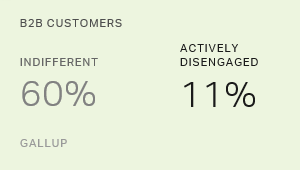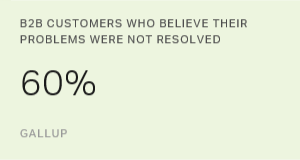Story Highlights
- Key account reviews uncover the nuances of B2B customer relationships
- Companies should review a wide range of accounts
- Teams need to act on the account review's results
For business-to-business companies, customer surveys have value -- but they're not enough.
Quantitative measures uncover only so much about the relationships between a business-to-business (B2B) company and its customers. To understand how its customers really feel, a company must also embark on a qualitative journey, which means having actual conversations with customers.
As an example, Gallup interviewed the CEO of a multimillion-dollar food distribution company on behalf of one of its clients. During the conversation, Gallup learned that the company was planning to let go of the client vendor.
A customer survey most likely would have shown that the food distributor was satisfied with the vendor. However, that survey alone might not have revealed how close the vendor was to being let go. Fortunately, Gallup connected its client with the food distributor to rectify the situation. But without that face-to-face conversation, the client most likely would never have known the status of its account -- until it was too late.
Evaluating Key Account Reviews
Qualitative inquiry can take many forms, but a key account review provides the surest path to understanding the nuances of customer relationships. And grasping those nuances is vital, especially as Gallup research reveals that only 29% of B2B customers are engaged, while 60% are indifferent and 11% are actively disengaged.

A key account review consists of a series of interviews with stakeholders in the company's most important accounts. Ideally, an impartial and trusted third party conducts the interviews to ensure complete candor.
Through a key account review, the company learns more regarding how customers feel about it and its approach with them in ways that numbers alone can't express. The company receives detailed descriptions of what is and isn't working in the customer relationship. The review allows leaders to highlight red flags in the relationship that the company needs to address immediately, along with more deeply rooted problems that require a more comprehensive solution.
For example, Gallup learned during a key account review that customers viewed a life sciences company as a prestigious partner to work with in its industry. However, when Gallup examined the results of the review, the company wasn't delivering the high level of service that its brand name seemed to represent. This finding went deeper than a customer service issue to the core of the company's brand promise and delivery of that promise.
The review process works because customer stakeholders are more likely to be straightforward with an impartial third party. In many cases, stakeholders have pent-up frustrations that they haven't been willing to share with the B2B company or that they have shared with company representatives with little to no response. Stakeholders often welcome the opportunity to speak with an objective third party, particularly if they feel the third party can help influence the B2B company's leadership to take action on their comments.
Selecting and Preparing for Key Account Reviews
The process of a key account review is generally straightforward. While there are many approaches to key account reviews and customer interviews, Gallup's structure is based on its extensive firsthand experience with B2B clients and their customers.
In selecting accounts to review, Gallup recommends including a wide range of accounts that fall into one of three categories:
1. High-Performing Relationships
- High growth
- Strong relationship
- Strong product penetration
2. Stagnant Relationships
- Low growth
- Good relationship
- Weak or stagnant product penetration
3. Struggling Relationships
- Declining growth
- Adversarial relationship
- Shrinking product penetration
After selecting accounts to review, the company provides the interviewer with a list of prospective stakeholders for each account. The goal here is variety in the stakeholder's role and the type of relationship with the B2B company. The company shouldn't limit the list to a handful of stakeholders who will give all positive responses. The company's leadership should validate and approve the list of stakeholders before submitting it to the interviewing team.
Companies should identify stakeholders for account reviews from their largest or most important customer accounts. This could mean conducting interviews with stakeholders from many accounts or from only a select few. The chosen stakeholders should come from different roles and levels of the customer organization -- ranging, in some cases, from the C-suite down to front-line procurement managers.
From each account, the company should include eight to 12 people within the customer organization, including at least two to three decision-makers -- that is, those with direct involvement in any purchasing decisions. If the customer is a multinational organization or has several distinct business units that need coverage, the number of people interviewed might be higher.
Gallup recommends as a best practice that the company CEO or other senior executive send an email to all prospective participants at the customer organization before scheduling any interviews. The email should highlight the importance of the review and ask for participants' cooperation. In some cases, the account or sales representative should also reach out to his or her contacts, letting them know to expect a call from an interviewer. These initial overtures tend to increase stakeholder participation rates significantly, particularly among those in more senior roles.
Using the Findings
Companies need a plan to ensure that everyone fully appreciates and acts on the account review's results. Gallup often briefs senior leadership and individual account teams on account review findings. Leaders typically take action on the more systemic findings. However, some problems or opportunities raised at the account level can be addressed only at the executive level -- for example, situations in which company leaders think the relationship with the customer is fine but the customer is extremely frustrated with ongoing quality and delivery issues.
Stakeholders also might talk about unique business opportunities for the B2B company that they might not have relayed to customer leadership through the normal sales or business development channels. Some of these opportunities might be in the early stages of development or go beyond the company's areas of expertise. Nevertheless, even a cursory discussion of the opportunity might provide the company with a chance to take its relationship with the customer to a higher level.
At the account level, each account team needs to develop an action plan based on the key account review findings. The team should focus on the top two to three priorities for that account, which the team can use as a starting point for its action planning discussions. Companies could appoint a project champion to help facilitate the creation of the action plans and to follow up with the teams on a regular basis to assess their progress on account priorities.


